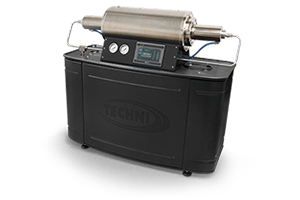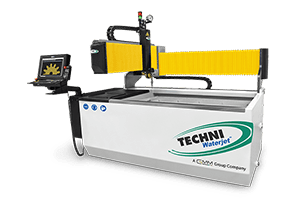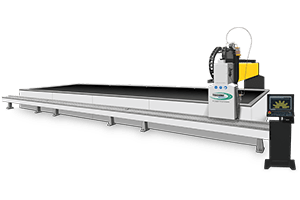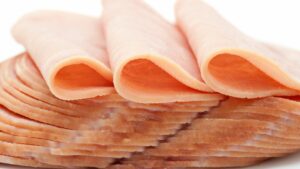Composite materials are a challenge to cut with traditional cutting methods. This is due to the high hardness and poor machinability of composites. Due to its superior performance characteristics, waterjet cutting has found extensive use in cutting composites.
This article will discuss the application of waterjet cutting for composite materials. You will learn about the different composite materials you can cut with the waterjet cutting process.
Overview of Waterjet Cutting
Waterjet is a cold-cutting technology. It uses the force of extremely high-pressure water to remove material from a workpiece. The waterjet process works for all types of materials, including metals, alloys, stone, wood, glass, composites, ceramics, and more. Waterjet technology finds application in countless sectors, such as the aerospace industry, healthcare, automotive, defense, architecture, and more.
Can You Cut Composite Materials With Waterjet Technology?
Yes, you can easily cut composites with water jet cutting technology. In fact, it is common for waterjet cutters to cut composite blocks up to 12 inches in thickness. There is no minimum thickness limit when cutting composite sheets with a waterjet. Alternative cutting processes only cut a few inches of thick composites.
The supersonic erosion of material by jet of water is very fast and precise. Abrasive materials are added to the water for harder materials. The process then turns into abrasive water jet cutting.
What are Composite Materials?
Composite materials are made by combining particles of different materials. The objective is to utilize the best properties of constituent materials. Composites usually show enhanced properties than their constituent materials. Physical strength is one of the common parameters that is improved considerably. This makes composites very hard to cut with machine tools. Composites are of two types- natural and synthetic.
What are the Common Types of Composite Materials?
Waterjet can cut through all types of composites. Some of the common composite materials that are cut using waterjet technology are:
Fiberglass
Fiberglass is a composite of plastic and glass. Glass fibers are added to plastic substances to enhance their properties. The resulting composite is stronger than many metals out there. Fiberglass can be molded into any shape required. Waterjet-cut fiberglass is used in aircraft windows, automobiles, boats, bath enclosures, pools, water tanks, surfboards, and many other components.
Carbon Fiber Reinforced Plastic (CFRP)
Carbon fiber reinforced plastic is commonly called carbon fiber or simply carbon. In CFRP, the strength of plastics is improved by adding carbon fibers. The resulting composite has an extremely high strength-to-weight ratio and stiffness. CFRP is expensive to manufacture. Therefore, waterjet cutting provides an efficient way to cut CFRP without wasting any material. Common applications of waterjet cut CFRP include making automotive frames, sports equipment, marine industry parts, cycle frames, and more.
Reinforced Concrete
Concrete is a very strong material by itself. However, adding reinforcement fibers to concrete takes its strength to the next level. Common cutting tools don’t work well on reinforced concrete. Tool breakage and accelerated wear are usual occurrences. However, the abrasive water jet can easily cut through thick concrete blocks. Waterjet-cut concrete is useful in art installations, construction, and the interior design sector.
Plastics
Plastics don’t inherently fall into the category of composite materials. Plastics become composites when reinforcements are added to it. This greatly increases the physical properties of plastics while providing a low-cost manufacturing material. However, plastic composites are negatively affected by heat. Waterjet cutting is the perfect option for cutting plastic composites since it is a cold-cutting process.
Paper
The paper industry was one of the first ones to adopt waterjet technology. Waterjet can cut very thick reams of paper without any issue. In fact, water jet also works well for other similar materials like wallpapers and textiles.
Plywood
Plywood is a composite that combines natural wood with artificial adhesive material layers. Plywood is used extensively in furniture, interiors, cabinets, construction, and other use cases. Waterjet cutters can cut multiple stacked pieces of plywood simultaneously. This is why waterjet technology is commonly used in industries manufacturing or using plywood.
Ceramic Matrix Composites
Ceramic matrix composites (CMC) include materials like alumina, silicon carbide, and mullite. These materials are brittle and can break with improper use of force. Waterjet cutting is ideal for these materials due to the highly narrow water beam. Waterjet cut CMC materials are used in heat exchangers, hot liquid filters, jet engine components, insulation, burners, and other applications.
Metal Matrix Composites
Metal matrix composites (MMC) contain fiber reinforcements spread into a base metal. Metal matrix composites have a higher toughness and damage tolerance than constituent materials. Common metals used in MMC are aluminum, magnesium, and titanium. MMC materials find use in making cutting tools, defense parts, aerospace components, consumer electronics, and marine parts.
Pros and Cons of Using Waterjet Cutting For Composites
Abrasive waterjet cutting is one of the best cutting processes for composites. The process has a lot of benefits and very few limitations. Let us go through each of these one by one:
Advantages of Waterjet Cutting For Composites
- Fast Process: Waterjet can cut composites in single-pass cutting. This speeds up the cutting process significantly.
- Versatile: Waterjet cutting can work on a wide range of materials. Therefore, a single machine can be used for multiple applications.
- Higher Production: Faster cutting speeds mean that manufacturers can produce more parts in any given time. This increases the production rate for the operation.
- Reduced Wastage: Waterjet cutting removes minimum material from the workpiece. This is due to the ultra-thin water stream. Therefore, material wastage is reduced in this process.
- High-Quality Cutting: The parts cut with a waterjet have smoother finish. This leads to the production of very high-quality parts.
- Accuracy: Waterjet technology has extreme precision and minimal kerfs. It is the go-to cutting method where secondary assembly is required.
- Cold Cutting Process: Waterjet is a cold-cutting process. There are no heat-affected zones with this technology. Therefore, there is no damage to the material in any way.
- Cost Saving: The faster production rate and reduced wastage mean manufacturers can produce parts cheaper. This makes waterjet technology a cost-saving process.
- No Cracking: Waterjet cutting works well even on extremely thin material thickness. Thin wafers of composite materials don’t crack when cut with a water jet.
- Dust Containment: The material removed in water jet cutting gets dissolved in the water. It leads to a dust-free workplace. Alternative cutting technologies tend to dirty the workplace. For instance, cutting CFRP with conventional methods creates a lot of carbon fiber dust. Waterjet dissolves the carbon dust, which can be strained later.
- Safety: Workers do not have to handle the waterjet cutting tool. The entire machinery is controlled automatically with CNC software. Therefore, this process has very high safety standards.
- No Distortion: The lack of heat-affected zones means there is no possibility of heat distortion or warping in the material.
- Stacking: You can stack multiple layers of material and cut them together. This works when same shape is required from multiple layers of material. It leads to exponential increase in production speed.
Disadvantages of Waterjet Cutting For Composites
- Pilot Hole: Waterjet cutting requires starting from the workpiece edge. If that is impossible, you must drill a pilot hole in the workpiece with the initial water beam.
- Tempered Glass: Tempered glass and diamonds are the sole exclusions for waterjet cutting. Tempered glass punctures on impact. Therefore, the waterjet stream cannot cut it.
- Operator Skill: Waterjet machines require a skilled operator for optimum results.
Applications of Waterjet Cutting of Composites
Waterjet works on a large range of materials. Therefore, many industries have utilized this technology for several use cases. Some of these use cases of waterjet technology are:
Architecture and Construction
- Cutting concrete panels for building sites
- Shower enclosures
- Bath tubs
- Wash basins
- Sinks
- Stone Countertops
- Pool panels
- Tiles
Sports Industry
- Badminton and tennis rackets
- Fishing poles
- Golf clubs
- Cricket bats
- Surfboards
- Skiing gear
Aviation and Aerospace
- Aircraft windows
- Frame
- Turbine blades
- Heat exchanges
- Insulators
Automobile Industry
- Racing car bodies
- Windows
- Display panel covers
- Dashboard
Furniture
- Cabinets
- Outdoor furniture
- Recreational equipment
Defense
- Kevlar based parts
- Apparel
How to Choose Waterjet Cutter For Composite Cutting?
Cutting composites can be as challenging as the toughest metals. Therefore, you must choose the right water jet equipment for the job. Here are some of the considerations that you should keep in mind:
Pure vs. Abrasive Waterjet Cutting
Softer composites like paper cardboard can be cut using a pure waterjet machine. On the other hand, harder composites like fiberglass will require an abrasive waterjet. Pure waterjet is cheaper and has reduced tooling costs. Consider the type of waterjet cutter you require.
Pump Pressure
Pump pressure has a major impact on the machine’s cost. The pump pressure is very application specific. Find the appropriate water pressure requirement for your job. It will save on the initial costs and provide better cutting results.
Build Quality
Waterjet cutters are a significant investment. Therefore, investing in a high-quality machine is always recommended. Superior build quality will avoid machine breakdowns and reduce maintenance costs significantly. It is better to spend a little extra towards build quality initially. Otherwise, you will pay that amount many times over during later repairs.
Features
Additional features such as underwater cutting, safety measures, vacuum assist valve, and software support can be useful. Underwater cutting in itself creates a quieter and dust-free workplace. Therefore, check the added features that your product offers.
Where to Find a Waterjet Cutting Machine?
Techni Waterjet is the leading supplier of waterjet equipment globally. These machines are very high quality with multiple safety levels. Every Techni Waterjet machine comes with complimentary software preloaded with basic cut shapes. You can add your own customized shapes and create any complex cuts required. All spare parts are available promptly whenever required.
Conclusion
Waterjet cutting is the best solution when it comes to cutting composites. The time and raw material savings with this method are tremendous. Other benefits of waterjet technology make alternative cutting processes feel very old school in comparison. Therefore, if you are searching for a cutting method for composites, look no further than waterjet. Contact Techni Waterjet to find the best machine for your requirements.













